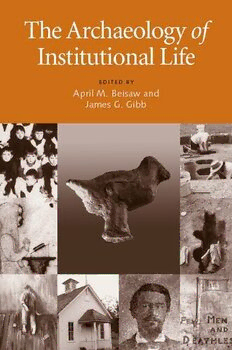
The Archaeology of Institutional Life PDF
Preview The Archaeology of Institutional Life
The Archaeology of Institutional Life The Archaeology of Institutional Life Edited by APRIL M. BEISAW AND JAMES G. GIBB THE UNIVERSITY OF ALABAMA PRESS Tuscaloosa Copyright © 2009 The University of Alabama Press Tuscaloosa, Alabama 35487-0380 All rights reserved Manufactured in the United States of America Typefaces: Minion & Triplex ∞ The paper on which this book is printed meets the minimum requirements of American National Standard for Information Sciences-Permanence of Paper for Printed Library Materials, ANSI Z39.48-1984. Library of Congress Cataloging-in-Publication Data The archaeology of institutional life / edited by April M. Beisaw and James G. Gibb. p. cm. Includes bibliographical references and index. ISBN 978-0-8173-1637-2 (cloth : alk. paper) — ISBN 978-0-8173-5516-6 (pbk. : alk. paper) — ISBN 978-0-8173-8118-9 (electronic) 1. Social institutions—History. 2. Social archaeology. 3. Archaeology and history. 4. Archaeology—Social aspects. 5. Social history. 6. Public history. I. Beisaw, April M. II. Gibb, James G. HM826.A73 2009 306.09—dc22 2008031052 Contents List of Illustrations vii Acknowledgments ix 1. Introduction James G. Gibb 1 2. Historical Overview of the Archaeology of Institutional Life Sherene Baugher 5 I. METHOD AND THEORY 3. On the Enigma of Incarceration: Philosophical Approaches to Confi nement in the Modern Era Eleanor Conlin Casella 17 4. Feminist Theory and the Historical Archaeology of Institutions Suzanne M. Spencer-Wood 33 5. Constructing Institution-Specifi c Site Formation Models April M. Beisaw 49 II. INSTITUTIONS OF EDUCATION 6. Rural Education and Community Social Relations: Historical Archaeology of the Wea View Schoolhouse No. 8, Wabash Township, Tippecanoe County, Indiana Deborah L. Rotman 69 7. Individual Struggles and Institutional Goals: Small Voices from the Phoenix Indian School Track Site Owen Lindauer 86 vi / Contents III. INSTITUTIONS OF COMMUNALITY 8. The Orphanage at Schulyer Mansion Lois M. Feister 105 9. A Feminist Approach to European Ideologies of Poverty and the Institutionalization of the Poor in Falmouth, Massachusetts Suzanne M. Spencer-Wood 117 10. Ideology, Idealism, and Reality: Investigating the Ephrata Commune Stephen G. Warfel 137 IV. INSTITUTIONS OF INCARCERATION 11. Maintaining or Mixing Southern Culture in a Northern Prison: Johnson’s Island Military Prison David R. Bush 153 12. Written on the Walls: Inmate Graffi ti within Places of Confi nement Eleanor Conlin Casella 172 13. John Conolly’s “Ideal” Asylum and Provisions for the Insane in Nineteenth- Century South Australia and Tasmania Susan Piddock 187 14. The Future of the Archaeology of Institutions Lu Ann De Cunzo 206 References Cited 215 Contributors 243 Index 245 Illustrations Figures 5.1. Oella School foundation and matching school plan 53 5.2. Dewey School in southeastern Michigan 56 5.3. Blaess School site map 61 5.4. Town Hall School site map 63 6.1. Wea View Schoolhouse No. 8 as it appeared in Brainard Hooker’s 1917 book 75 6.2. Wea View Schoolhouse No. 8 site map 79 7.1. Phoenix Indian School map depicting the Track Site 89 7.2. Artifacts from the Phoenix Indian School 98 8.1. Residents of the orphanage at Schulyer Mansion 109 8.2. Doll parts excavated from Schuyler Mansion 111 9.1. Falmouth Poor House building, now the Artists’ Guild 121 9.2. Plan view of the Falmouth Almshouse 123 10.1. Ephrata Sisters’ House and Prayer House 142 10.2. Plan view of Kedar posthole pattern 144 10.3. Plan view of Ephrata Cloister historic site 145 10.4. Pottery found on the Mount Zion dormitory site 148 viii / Illustrations 11.1. Gould map of Johnson’s Island Military Prison 154 11.2. Site map of Johnson’s Island Military Prison 158 11.3. Hard rubber crafts from Johnson’s Island Military Prison 168 11.4. Distribution of craft materials from Johnson’s Island Military Prison 169 12.1. Cell graffi ti from Fremantle Prison, Western Australia 177 12.2. Cell graffi ti from Dungeons of the Palazzo Ducale and Fremantle Prison 178 12.3. Cell graffi ti from Fremantle Prison, Western Australia 184 12.4. Cell graffi ti from Kilmainham Gaol, Ireland 185 13.1. Watercolor painting of Adelaide Lunatic Asylum 193 13.2. Plan view of the Adelaide Lunatic Asylum 194 13.3. Plan view of Parkside Lunatic Asylum 195 13.4. Plan view of New Norfolk Hospital 198 Tables 5.1. One-room schoolhouse site formation process model 55 6.1. Artifacts found in privies at Wea View Schoolhouse No. 8 82 6.2. Minimum number of vessels from Wea View Schoolhouse No. 8 83 13.1. Conolly’s ideal asylum features and their actual frequency 191 Acknowledgments Baugher, Chapter 2. I wish to thank the editors, April Beisaw and James Gibb, for inviting me to be part of this book and for reading and com- menting on drafts of this chapter. They also deserve many thanks for their dedication and perseverance in taking an SHA symposium, expanding the papers, and then transforming them with the addition of new chap- ters into this book. I wish to express my appreciation to Suzanne Spencer- Wood for her very helpful editorial suggestions. Many thanks go to Lu Ann De Cunzo for the numerous enjoyable discussions we had brainstorm- ing about our “bookend” chapters and how to approach the past, present, and future of the archaeology of institutional life. Finally, I give heartfelt thanks to my husband, Robert W. Venables, for his support and encourage- ment. I always appreciate the insights he brings as a historian, and I enjoy his challenging questions. Spencer-Wood, Chapter 4. I would like to thank Eleanor Casella for refer- ring me to Nicole Rafter and other feminist penologists. My thanks also to April Beisaw for her hard work in shortening this chapter. Of course, any remaining errors are mine. Beisaw, Chapter 5. The Michigan Archaeology Society and the Saline and Pittsfi eld, Michigan, historical societies, residents, and town offi ces, provided signifi cant assistance with the Blaess and Town Hall School proj- ects. Thanks to the National Park Service, Hannah Geddes Wright, Anna Agbe-Davies, Stephen Wald, and Julie Schablitsky for providing informa- tion about their research. Stanley Loomis, a former student, and Dr. Joseph
